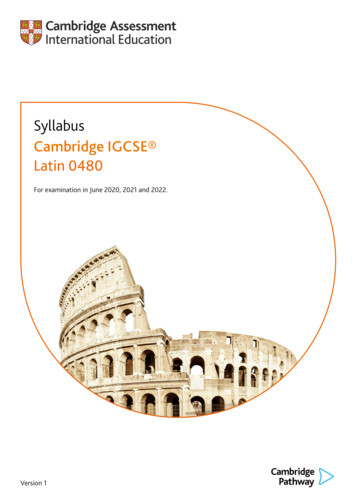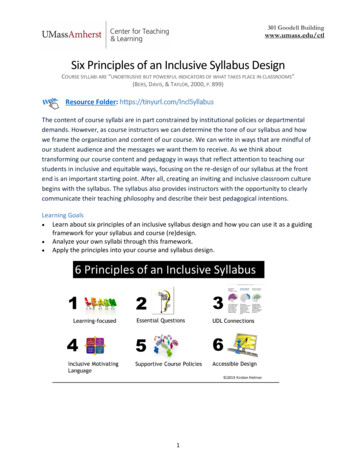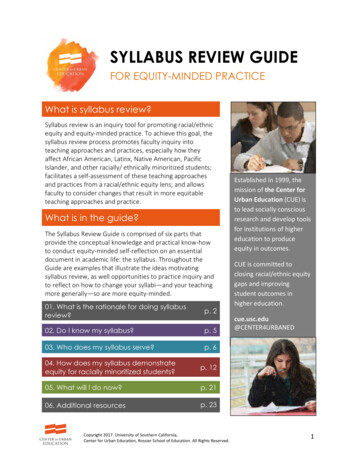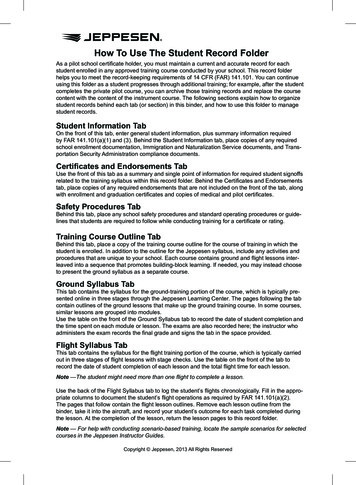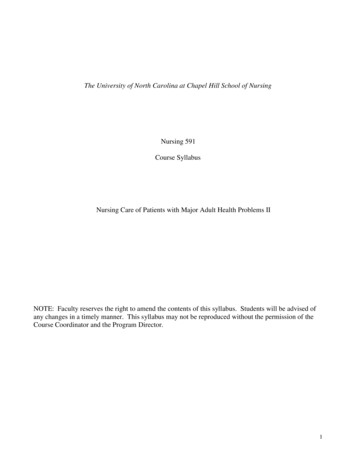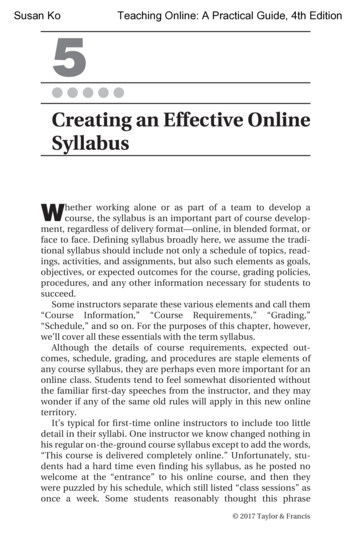
Transcription
Susan Ko5Teaching Online: A Practical Guide, 4th Edition Creating an Effective OnlineSyllabusWhether working alone or as part of a team to develop acourse, the syllabus is an important part of course development, regardless of delivery format—online, in blended format, orface to face. Defining syllabus broadly here, we assume the traditional syllabus should include not only a schedule of topics, readings, activities, and assignments, but also such elements as goals,objectives, or expected outcomes for the course, grading policies,procedures, and any other information necessary for students tosucceed.Some instructors separate these various elements and call them“Course Information,” “Course Requirements,” “Grading,”“Schedule,” and so on. For the purposes of this chapter, however,we’ll cover all these essentials with the term syllabus.Although the details of course requirements, expected outcomes, schedule, grading, and procedures are staple elements ofany course syllabus, they are perhaps even more important for anonline class. Students tend to feel somewhat disoriented withoutthe familiar first- day speeches from the instructor, and they maywonder if any of the same old rules will apply in this new onlineterritory.It’s typical for first- time online instructors to include too littledetail in their syllabi. One instructor we know changed nothing inhis regular on- the-ground course syllabus except to add the words,“This course is delivered completely online.” Unfortunately, students had a hard time even finding his syllabus, as he posted nowelcome at the “entrance” to his online course, and then theywere puzzled by his schedule, which still listed “class sessions” asonce a week. Some students reasonably thought this phrase 2017 Taylor & Francis
Susan Ko112Teaching Online: A Practical Guide, 4th EditionTeaching Onlinereferred to online, real- time chat. Others wondered if the phrasemeant that their asynchronous communications should be postedonly once a week, on the particular day named in the schedule. Asa result of this lack of clarity, the first week’s discussion forum wasdominated entirely by questions about where, when, and how todo the assignments, and the main topics for that week were nearlyforgotten in the confusion.Even after the instructor’s hurried explanations, students continued to experience confusion about dates and times, procedures,and grading. They could refer back to the first week’s forum andsearch through the various discussion threads in which thesequestions had been raised, but they had no clear reference document to which they could turn. One student even had a gradedispute with the instructor that arose from an ambiguity in the syllabus. In the syllabus, the instructor had declared that all lateassignments would be penalized at the rate of one- quarter gradepoint each day, but hadn’t clearly specified that the due dates forassignments were based on the instructor’s time zone, not the student’s. Thus, the student claimed that, when he posted an assignment at 11:00 p.m. Pacific time, on the due date, he was unfairlypenalized because the server on which the course was housed,located (like the instructor) on the East Coast of the United States,had recorded the time as 2:00 a.m. the following day. These examples, both serious and trivial, illustrate some of the problems thatcan ensue if online syllabi (and, naturally, subsequent directions)aren’t thorough and detailed.In blended courses clear directions are equally vital. It’simportant, for instance, to explain to students how the mixture ofdifferent venues will be integrated. Which course activities willtake place in the on- campus classroom, which in the online classroom, and what’s the sequence of procedures students shouldfollow each week? Imagine that, before the face- to-face classmeeting on Wednesday, you want students to read the onlinelecture and post a preliminary report, but you want them to waituntil after the class meeting to take part in that week’s online discussion. In many cases, they won’t understand that sequenceunless it’s carefully explained to them.There are three aspects of an online syllabus we want toemphasize in particular: the contract, the map, and the schedule. 2017 Taylor & Francis
Susan KoTeaching Online: A Practical Guide, 4th EditionChapter 5 Creating an Effective Online Syllabus113 The ContractIncreasingly, the syllabus has come to be the contract betweenstudents and instructor, laying out the terms of the class interaction—the expected responsibilities and duties, the grading criteria,the musts and don’ts of behavior. Let’s look at some features of thecontract that are especially important for an online course.Class Participation and Grading CriteriaWhat’s meant by “participation” in the online setting won’t beobvious to students. Participation should be defined. For example,is it posting, that is, sending messages to the classroom discussionboard? Or is it just logging on and reading (an activity revealed toan instructor only when course management software has thecapacity to track students’ movements online)? Perhaps participation includes taking part in an online group presentation orshowing up for a real- time chat.Important! Whatever kind of participation you expectin your course, you should make that explicit in thesyllabus.If you’re going to count participation toward the final grade, youshould define how that will be calculated. We recommend, in fact,that you always give a grade for active participation in the class,that is, for contributing to discussions and asking or answeringquestions. The plain fact is that if students aren’t graded, the greatmajority won’t actively participate. For a blended class, you willwant to decide whether students are given participation gradesfor both face- to-face meetings as well as online participation,and how the grade for one, the other, or both should be dividedup. Besides judging the quality of students’ contributions in theclass, you may want to set a minimum level for quantity of participation or require that a portion of postings be responses toclassmates.Another consideration in asynchronous courses is the degree ofself- pacing allowed. Must students follow a chronological order oftopics in their participation, or can they go back and respond toprevious weeks’ topics? 2017 Taylor & Francis
Susan Ko114Teaching Online: A Practical Guide, 4th EditionTeaching OnlineCan they complete assignments at different times during thecourse? The answers to these questions really depend on thenature of your course. For example, if your course has a setnumber of tasks, which can be completed at any time or in anyorder within the twelve weeks of the course, then you may not beconcerned about students skipping about or restarting conversations about previous weeks’ topics.Managing Student ExpectationsThe task of managing student expectations is very important inthe online classroom. Some students enroll in an online courseexpecting it to be much easier than a regular course. Othersimagine that the course will be something like independent study.Still others think the instructor should be available for twenty- fourreal- time hours a day. Your syllabus as well as your introductorycomments can help manage such expectations, correct falseimpressions, and set the stage for the smooth unfolding of yourcourse.It’s also helpful if your institution has a general student orientation (or at least a student handbook or web tutorial) that explainshow the online course will work, how much student–instructorinteraction can be expected, and so forth. If your institutiondoesn’t have such an orientation, or your class has a uniqueapproach that goes beyond the typical online offerings at yourinstitution, you may need to supply some of this information inyour own syllabus. Michelle Pacansky- Brock, currently serving asTeaching and Learning Innovation Specialist at CSU ChannelIslands previously taught an online Art Appreciation class forSierra College that was unusually rich in its use of technology andmultimedia. In her syllabus she cautioned students about thatfact, “Important!!! This online class is image intensive. Due to thevisual nature of the content of this class, you will regularly download large files containing high resolution images and movies . . .”A continuing- education instructor we know, who has a busyprofessional practice, complained after a few weeks of her onlineclass that students had “unrealistic expectations.” When pressedto explain this remark, she commented that if she didn’t reply toeach and every student comment in the discussion forum or ifshe appeared not to be in the online classroom every day, shewould receive plaintive email queries or even classroom postings 2017 Taylor & Francis
Susan KoTeaching Online: A Practical Guide, 4th EditionChapter 5 Creating an Effective Online Syllabus115inquiring about whether she had read a particular message. Shefurther explained that she had expected students to work on theirown during the first part of each week and only then to post theirthoughts in the discussion forum. Unfortunately, neither her syllabus nor her introductory comments ever mentioned theseteacher expectations.This case shows that managing student expectations can alsorequire an instructor to communicate her expectations for herselfto the students. This type of problem can be handled by a simplestatement in the syllabus to the effect that the instructor will lookin frequently during the week but may not be in the classroomevery day, or that students should work on the week’s assignmentsduring the first part of the week (say, Monday through Wednesday) and then post their responses later in the week (Thursdaythrough Sunday).For her blended class, Isabel Simões de Carvalho, teaching atLisbon’s Instituto Superior de Engenharia, expressed her availability online in the following manner:Your teacher will be online with all of you at least every twodays and will provide feedback within forty- eight hoursmaximum. However, if you have an urgent subject that youneed to discuss with your teacher . . . then you should send anemail to the instructor and in this case, do not forget to fill inthe course name within the subject line.Other information of a “contractual” nature that you might wantto incorporate in your syllabus includes the following: your policy on late assignments; whether due dates are calculated by your time zone or the student’s (or the server’s, as that might actually be in a third timezone); your availability for real- time chat appointments (which somecall “virtual office hours”); overall specifications for writing assignments (Formal essay?Informal journal? Of how many total words? MLA or APA style?); your institution’s policy on plagiarism and cheating. 2017 Taylor & Francis
Susan KoTeaching Online: A Practical Guide, 4th Edition116Teaching Online The MapIn this new territory of the online classroom, students will seizeupon your syllabus as if it were a map. Students will want to knowhow to proceed and where everything is located. So, one of thefirst things you must do, whether through the syllabus or in anintroductory message, is to explain the “geography” of the course.In fact, if the syllabus isn’t visible on the first level of the course,but instead can be arrived at only by one or two clicks of themouse, then this introductory set of directions must be given in anannouncement area or even delivered prior to the course, byemail. For example, an announcement with explicit directions tothe syllabus might say:Welcome, please click on the Class Information tab at the upperleft hand corner of this web page to find the links labeled syllabus, and weekly schedule. These will guide your work in thiscourse, so I recommend that you print these sections out forhandy reference. If you have any questions about these documents, please post a question in the Q&A forum portion of thediscussion area.What else does “explaining the geography” mean? If your courseconsists of various web pages plus a discussion forum, you’ll needto let the students know where to find the component parts of thecourse and under what headings: “Lectures will be on the pagewhose link says ‘Lectures,’ and these are arranged by weeks.” If thediscussion forum, a blog, or other software is hosted on an outsidesite, students need to be told that this link will take them off theuniversity server, or that they must use a password given to them,and so on. If you’ve created a discussion forum dedicated to casualcommunications and socializing for students, let them know thatthe area you have imaginatively labeled “Café Truckstop” isintended to be the online equivalent of a student lounge.This is particularly important when using learning managementsoftware that has its own unique and not easily customizable category headings or when your institution or department does nothave a common classroom template. Students will need to knowwhat you have stored behind each of the online classroom headings or where a particular link might lead. 2017 Taylor & Francis
Susan KoTeaching Online: A Practical Guide, 4th EditionChapter 5 Creating an Effective Online Syllabus117While not essential, a narrated guide or video tour to the syllabus can be created by an instructor to reinforce the importanceof the syllabus and to draw attention to it from the very first day ofthe course. You can use a simple series of screen shots within aPowerPoint narration or use screencasting video software tocapture your movements as you click about the syllabus to pointout the various sections of the document.In a blended course that combines face- to-face and onlinecomponents, it’s essential that you specify where to do each activity. For example, in Isabel Carvalho’s blended course syllabus sheclearly stated, “Besides the weekly face- to-face sessions, thiscourse has an online learning environment. The face- to-face andonline components are not independent but instead are considered to be complementary.” She added,We will be together face- to-face 4.5 hours per week and I willexpect you all to spend at least 2 hours a week online using thediscussion forum, viewing and downloading course resourcesand materials, and interacting with your peers.Such general statements are then further detailed in the classschedule.Other procedural and “geographical” issues you might want tocover in the syllabus include these: the URL for your home page, the companion website for a text,or other resources; where to access and how additional technology tools will beused in the class; how emailed assignments or those submitted via the LMS are tobe labeled in the subject line; which file types you’ll accept for attached documents (forinstance, Microsoft Word, Rich Text Format, PowerPoint, PDF,Excel); any contact information for technical and administrativesupport; the proper sequence for accomplishing weekly activities andassignments (for example, do the exercises before taking thequiz, post a message in discussion before emailing theassignment). 2017 Taylor & Francis
Susan Ko118Teaching Online: A Practical Guide, 4th EditionTeaching Online The ScheduleThe course should be laid out by weeks for students, because thisis commonly the unit by which students gauge their own participation and work. If your class starts on a Wednesday, thenTuesday will become the last day of your week unless you stateotherwise. If your first week of class is a shorter than usual one,say, starting on a Thursday, you can, if otherwise allowed by yourdepartment, let students know that the first week is a shorter thanusual one, running Thursday through Sunday, and that subsequent weeks will all run Monday through Sunday. Arranging forweeks to end over a weekend can be very helpful for adult studentsin particular.We recommend that you think in terms of subdivisions of twoor three- day spreads. For example, if you post your lecture onMonday, allow students through Wednesday to read and commenton it rather than asking them to do so by Tuesday. Students can betold to log on every single day, but it is perhaps wiser to takeadvantage of the asynchronous flexibility of the online environment. Assume that some students will log on and read on Mondaynight, some on Tuesday morning, and others at midnight. TheMonday reader may return on Tuesday night to reread and post.The Tuesday reader may respond with comments at once. Thisscheduling flexibility is even more important for those who havestudents in different time zones or in foreign countries.It’s also good to gauge your students’ access to computers ormobile devices and their probable work schedules. This goes backto what we discussed in earlier chapters. If your students areaccessing the course website from a campus lab, the dorms, orbranch campus libraries, then they’ll follow a different patternthan will typical working adults or continuing- education students,who may want to use the weekends to do most of the time- intensive assignments. A Monday or Tuesday due date for assignments will allow working adults to make the most of their studytime out of the office.Using Specific DatesInstead of simply listing the course schedule for “Week One” and“Week Two,” your schedule should include the specific dates for 2017 Taylor & Francis
Susan KoTeaching Online: A Practical Guide, 4th EditionChapter 5 Creating an Effective Online Syllabus119A Checklist for Your Online SyllabusHere, in summary form, is a checklist for creating your online syllabus.You needn’t include all of these items (some may be more appropriate for your class than others), nor do you have to include them all inone document called a “syllabus.” You can distribute this informationamong several documents if desired. Course title, authors’ and instructor’s names, registration number,and term information; syllabus web pages should bear creation or“last revised” dates if the term date isn’t included at the top. Course instructor’s contact information, indication of instructoravailability in classroom, for “office hours” and private communications. Contact information for technical support. Course description, perhaps the same as the description used fora course catalog listing, but probably more detailed; should listany prerequisites or special technical requirements for the course;if blended course, define what is meant by blended in regard toface- to-face class meetings and required online work. Course objectives or expected outcomes; what students canexpect to learn by completion of the course. Required texts or materials: any books or other materials, such assoftware, not made available in the course but required for thecourse. Explanation of grading criteria and components of total grade: alist of all quizzes, exams, graded assignments, and forms of classparticipation, with grade percentages or points; criteria for apassing grade; policies on late assignments. More detailed instructions for assignments should be included elsewhere but at the veryleast, the outlines and due dates of each major assignment shouldbe listed first in the syllabus. Participation standard: minimum number of postings per week indiscussion and any standards for quality of participation. If a rubricwill be used to evaluate participation, reference to the rubric andwhere it may be found can be provided rather than including thewhole rubric in the syllabus. Explanation of course geography and procedures: how the onlineclassroom is organized; how students should proceed each weekfor class activities; how to label assignments sent by email; whereto post materials in the classroom; any special instructions. Week- by-week schedule: topics, assignments, readings, quizzes,activities, and internet resources for each week, with specificdates. 2017 Taylor & Francis
Susan Ko120Teaching Online: A Practical Guide, 4th EditionTeaching Online Any relevant institutional or program policies, procedures, orresources not mentioned above. These may be available as linksto institutional web pages.Sometimes it’s difficult to anticipate every issue that may arise duringthe class and to include that in your syllabus. There’s obviously abalance between readable brevity and a syllabus so voluminous as tobe intimidating. Whatever you do not include in your initial documentscan be referenced for further examination—for example, “DiscussionParticipation is worth 20 percent of the grade. See the rubric for participation posted in the Major Assignments section of the onlineclassroom”—or may still be introduced by means of announcements,weekly emails sent to all students, or postings in an appropriateforum. You will also want to use these means to reinforce importantelements of your syllabus as the course progresses.each unit, week, or topic area covered. This is particularlyimportant for asynchronous courses in which students may belogging on at diverse times and days during the week. It’s quitecommon for students to lose track of the weeks in the term whenfollowing an asynchronous online schedule. (And it’s not unheardof for instructors to forget the dates, either!)If you don’t want to include dates on the main syllabus webpages because you want to reuse it for subsequent terms, andworry about making mistakes in updating it, then send studentsan email version of the syllabus or post a downloadable documentversion with the relevant dates inserted. Some learning management software includes a calendar feature that you may use toreinforce the dates for each segment of the course. However, don’tassume that all students will check the calendar, especially if it isonly available when they are inside the LMS. It is generally moreeffective to include the dates in a downloadable syllabus scheduleif you want to ensure that students will have something at handthat they can consult with relatively greater frequency.Schedule Format It is vital that your schedule is readable andeasily scanned by the eye. That means you need to have clear andconsistent headings and spacing that allow one to grasp the whatand the when and how of each week, task, or assignment. If yourschedule is complicated, with many contingent tasks or containsmany different readings or activities, a table is often the best 2017 Taylor & Francis
Susan KoTeaching Online: A Practical Guide, 4th EditionChapter 5 Creating an Effective Online Syllabus121solution. Tabular format is particularly helpful for blended classesin which the coordination of face- to-face meetings and activitiesand those performed online requires clarity and precision. Wehave provided examples of two display formats here, with the listview for the online syllabus example and the tabular view for theblended syllabus example.Supplying Information More than OnceIt’s easy to lose track of where and when something was said inthreaded discussions or by email. When you give directions, it maynot be possible for students to simply link back to them at a laterdate. For that reason, you should provide important instructions inmore than one location. However, to maintain consistency andaccuracy, you will either need to repeat that information in full orrefer students back to the complete directions in the syllabus orother central document. Be very careful not to truncate yourinstructions for an assignment—in posting reminders, always referstudents back to the most detailed version. For example, anannouncement can note an upcoming due date for an assignmentmentioned elsewhere, “Remember, papers are due this week andmust be a minimum of 1,000 words and based on at least threescholarly resources. Please review the assignment details for thispaper found in the syllabus and under Major Projects.” Or you mayrespond to a question in the discussion area, “John, your papermust be on one of the topics listed and Wikipedia may not be oneof the three scholarly resources. Please refer to the Major Projectsarea for full details on topics and resources for this assignment.”Important! In an online environment, redundancy isoften better than elegant succinctness.Although students in some learning management platforms maybe able to use a search function to find your instructions, in manycases students will have to waste energy and time to sift throughmaterials before they can locate that one crucial sentence of direction. Therefore, even if you intend to explain assignments andprocedures later in the course, it’s best to state them up front inthe syllabus as well. Then, if your course is laid out entirely in webpages, make sure that each page permits students to link backeasily to essential information in the syllabus. 2017 Taylor & Francis
Susan Ko122Teaching Online: A Practical Guide, 4th EditionTeaching Online Sample Syllabi: Online and Blended CourseVersionsThe following is a composite syllabus based on courses in ModernChina taught by Susan Ko at a variety of institutions. The first is asyllabus for the fully online version, followed by one representinga blended version of the same course. Both are designed as ten- week courses, but only the first five weeks of the course are provided here in the schedule portions.Modern China: History and CultureHISTORY 415Delivered online, SomeUniversity Spring term, **** yearCourse DescriptionThis online course provides a survey approach to the history andculture of China in the modern period, from the mid- nineteenthcentury through the year 1990.Contacts and CommunicationsInstructor: Dr. Susan Ko, sko@someuniversity.eduSee my instructor’s bio in the classroom link under my name.Please contact me via the email address above or feel free to usethe classroom instant message (IM) tool when you see me amongthe names of those currently logged in. I am also available byappointment on Skype.I will log on to the classroom nearly every day and the discussionarea Q&A forum is generally the best place to ask most questions.But if you need to contact me on an individual basis, please useemail and I will try to reply within twenty- four hours. Your communication is important to me! To ensure that I see your messageamong my email, please use the class name and number HIST 415in your subject line. For those of you halfway across the world fromthe instructor’s eastern US location, given the time differences youmay have to allow up to thirty- six hours for a “prompt reply.”Technical support is available 24/7 by contactingtech24@7help.edu or calling 1–800-TECHELP. 2017 Taylor & Francis
Susan KoTeaching Online: A Practical Guide, 4th EditionChapter 5 Creating an Effective Online Syllabus123Your Online Classroom and ProceduresEach class week begins on Monday and ends on Sunday.Although all students will have taken the software orientation, at anypoint you may review the learning management software featuresby clicking on the Guide link.The Announcements area of the classroom that you see eachtime you log in will be used on at least a weekly basis to postupdates and comments on class matters. The instructor will alsoemail the class to remind students of important due dates. (If youprefer to receive text message versions of these emails, please letthe instructor know by following the instructions posted in theclassroom.)The Course Materials area, arranged in folders by week, housesthe content for the course. All materials for the course are postedand can be reviewed from the start of the class. There is also afolder within Course Materials labeled Detailed AssignmentInstructions that provides full information, criteria, rubrics, andsamples for completing each assignment.The Discussion area contains at least one discussion forum foreach week of the course. Each discussion forum will be opened forposting on the Saturday before each new week begins. There is aforum labeled “Student Lounge” for casual conversations as well asa general “Q&A” forum where questions about class requirementsor other questions that do not fit into a weekly discussion may beasked. It is recommended that you “subscribe” to the Q&A forum sothat you can receive notification via email each time a question isposed or answered.The Assignment area is the place to submit individual assignments unless otherwise indicated in assignment instructions.Click on the link for each assignment to submit your work.Remember that our classroom server is set to US Eastern time.Therefore all due dates are noted as of US Eastern time. Use theWorld Time Clock link available in the classroom to convert all timesand dates.IntroductionThis ten- week course provides a general survey of Chinese historyand culture in the modern period, from the Qing dynastic periodthrough the founding of the People’s Republic and post- Mao China 2017 Taylor & Francis
Susan Ko124Teaching Online: A Practical Guide, 4th EditionTeaching Onlinethrough 1990. We will try to trace the continuing themes as well aschanging conditions that mark China’s tumultuous modern history.This course is conducted completely online. To do your best inthis course, it is recommended that you download or print out thissyllabus to keep as a reference, log on frequently (at least 3–4times a week) to the online classroom and keep up with all assignedreadings and internet work.Course Objectives Describe the major cultural, political, and social elements of traditional China. Trace recurring themes and concepts in Chinese history. Identify the major historical figures and events that have shapedmodern Chinese history. Analyze the underlying themes and issues in the modernizationprocess, including those in the economic, political, and socialspheres. Differentiate the characteristics of the Chinese state in the Maoand post- Mao era. Demonstrate an appreciation for Chinese arts or literature as areflection of Chinese society and values in different historicalperiods.Course Textbook and MaterialsMain textbook:
Creating an Effective Online Syllabus Whether working alone or as part of a team to develop a course, the syllabus is an important part of course develop- ment, regardless of delivery format—online, in blended format, or . nature of your course. For example, if your course has a set number of tasks, which can be completed at any time or in any



